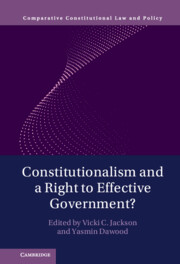Book contents
- Constitutionalism and a Right to Effective Government?
- Comparative Constitutional Law and Policy
- Constitutionalism and a Right to Effective Government?
- Copyright page
- Dedication
- Contents
- Tables
- Contributors
- Acknowledgments
- Part I Introduction
- Part II What Are Constitutions For?
- Part III Positive Rights and Rights to Effective Self-Government
- Part IV The Role of Courts in Building State Capacity and Promoting Effective Self-Government While Protecting Rights
- Part V Executive and Administrative Constitutionalism in Effective Democratic Government
- 12 What Does Effective Government Have to Do With the Constitution?
- 13 The President’s Two Bodies
- Part VI Legislatures, Representation, and Duties of Effective Self-Government
- Part VII Politics, Sociology, Media, and Corruption as Contexts for Constitutionalism and Governance
- Index
13 - The President’s Two Bodies
from Part V - Executive and Administrative Constitutionalism in Effective Democratic Government
Published online by Cambridge University Press: 20 October 2022
- Constitutionalism and a Right to Effective Government?
- Comparative Constitutional Law and Policy
- Constitutionalism and a Right to Effective Government?
- Copyright page
- Dedication
- Contents
- Tables
- Contributors
- Acknowledgments
- Part I Introduction
- Part II What Are Constitutions For?
- Part III Positive Rights and Rights to Effective Self-Government
- Part IV The Role of Courts in Building State Capacity and Promoting Effective Self-Government While Protecting Rights
- Part V Executive and Administrative Constitutionalism in Effective Democratic Government
- 12 What Does Effective Government Have to Do With the Constitution?
- 13 The President’s Two Bodies
- Part VI Legislatures, Representation, and Duties of Effective Self-Government
- Part VII Politics, Sociology, Media, and Corruption as Contexts for Constitutionalism and Governance
- Index
Summary
American constitutionalism consists of two quite foundational, conflictual, but ultimately interdependent understandings of the presidency – what we might think of as the president’s “two bodies.” On one view, the presidency is an individual – a “he” (maybe one day “she”). Presidential power is individualistic along three dimensions: it is singular, temporary, and personal. On the other view, the presidency is an institution. It is composite, permanent (or at least indefinite), and impersonal. Ever since George Washington embodied the idea of an institution still in the making, we’ve had this deep tension – these competing impulses between a personal or charismatic president and a more impersonal and deliberative institutional presidency. Public law reveals different perspectives on how to manage this duality. But public law cannot resolve it. Rather, the president’s “two bodies” is the defining ambiguity of the constitutional office. It is the conception on which our understandings of presidential power rest.
- Type
- Chapter
- Information
- Constitutionalism and a Right to Effective Government? , pp. 167 - 178Publisher: Cambridge University PressPrint publication year: 2022



